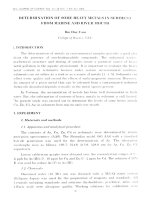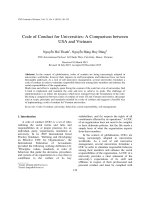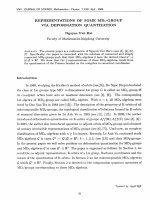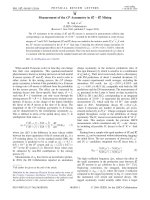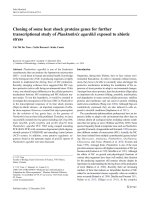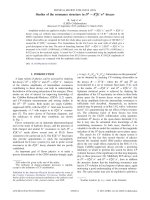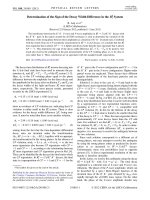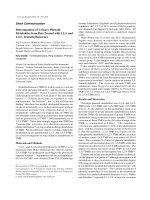DSpace at VNU: Determination of some heavy metals in sediment from marine and river mouth
Bạn đang xem bản rút gọn của tài liệu. Xem và tải ngay bản đầy đủ của tài liệu tại đây (1001.34 KB, 7 trang )
VNU JOURNAL QF SC IEN C E, Nat , Sc» & Tech , r XIX No1. 2003
DKTERMINATION OKSOMK HEAVY METALS IN S K i m i K N T
I ROM MA RI NE ANI) R1VKR MOUTH
Bui Duy Cam
C o lle g e o f S cie n c e . V N l ’
[. INTRODUCTION
The đetermination of metals in environmental samples provides a good 1(I(M
ib o u t
th e
p re s e n c o
nf
n o n -b io d ế *g ríu ia h le
ro m p o iin c ls
The
in d u s t r ia l
w a s to s ,
'eochemieal structure and mining of metals create a potential source of heavy
netal pollution in the aquatic environment. It is important to evaluate the heavy
ìietal content in sediments because under certain environmental condition,
iediments can act either as a sink or as a source of metals [ 1 , 4, 5]. Sedimcmts can
efloct water quality and record the effects of anthropogenetic emission. Moreover,
he amount of a given metal that can be released from a contaminated sediment
ĩhemically disturbed depends critically on the metal species present.
In Vietnam, the accumulation of metals has been vvell documented in fresh
vater. But, the inĩormation of contents of heavy metals in sediment is still lim it r d .
nhe present study vvas carried out to determine the levels of some heavy metals
Cu, Zn, Cd, As) in seđiment from marine and river mouth.
B. EXPERIMENT
/. M a te r ia ls a n d m e t h o d s
ỉ. 1 A p p a r a t u s a n d a n a l v t i c a l p r o c e d u r e
The contents of As, Cu, Zn, Cd in sediments were determined hy atomic
a>sorption spectrometry (AAS). The Shimacỉzu model 680 AAS with a S t a n d a r d
K’dride generation was used for the determination of As. The absorption
vavelenghs were as follows: 193.7; 324.8; 213.9; 228.8 nm for As, Cu, Zn, ( (1
r*spectively.
Linear calibration graphs were obtained over the concentration rnngos of 0 *
2 ) ppb for As (III); 0 - 1 0 ppm for Cu and Zn; 0 - 2 ppm for Cd. The solution of 20°o
H was used for reduce As (V) to As (III).
1.2. C h e m i c a l s
Deionised water (16 Mí} cm) was obtained with a Mili-Q vvater system
(ilillipore elapan) was usecỉ for the preparation of reagents and standards. AU
c.emicals including standards and solutions (hydrochloric, pcrchloric, nitric: and
s lfuric acid) were ultrapure quality. VVorking solutions for calibration \verc1
(
Hui Duy Ciata>a,am
prepared from com m ercially available 1000mg/l solutions for atomic absorp)tLÌciaicion
spectrometry (Wako Pure Chemical Industries Ltd. Japan). As reference materiíalalalals
DORM-1, DORM-2 (Dogíìsh muscle - Canada National Research Council) ỉamraiand
NIES-CRM-02 (Poncỉ Sediment - National Institute of Environmental Stiudiidididies
Japan) were employed.
All glassware vvas treated with 10% v/v lỉNOi for 24h. and then rinseđ khinrartree
times with Mili-Q water before use.
2. S a m p l e c o l l e c t i o n
Sediment samples of marine and river mouths vvere collected in August 12(0(.)0)0)00.
Sediments of river mouths were collected at depths of 0-10 cm, 25-35 cm, 105- 1 1-1*140
cm to provide an inđication of the rate of contamination. All samples were paic:k kckcked
into plastic bags and kept frozen until analysis. The samples were dried at 3CHC3 c 2 to
constant vveight and then vvere ground and passed through a sieve. The sediimieieieient
was stored in clean acid-soaked polyethylene packets.
3. D ig e s tio n o f s a m p l e
The sam ple of o.õg w as w eighed into conical beaker and was digested 'Wvvivivith
lOml of acid mixture ( H N 0 ;ỉ-HC104-H >S04). The sample was heated on the hot p)hlalaỉate
w i t h a g la s s c o v e r a t 2 2 0 ’C f o r a b o u t 8 h. A f t e r th e c o lo u r o f s o lu tio n is lig h yelllo'w < v -V V o r
white, cool it. VVash t he glass cover with 2ml of UNO ị. Then, evaporate a solutsionn n ri at
220 c un to dry (like sirup).
The residue was dissolved in 25ml of 0.5N IINO ị. Kilter the susptemcidid ded
solution with Toyo íilter paper No 5C. Wash the beaker and filter paper for t h h n n r e e
times with O.õN UNO ị. At last, weigh all the sample solution.
111. RKSULTSANI) DISCUSSION
/. S t l i d y o f ( ỉ i g e s t i o n o f s a m p l e
Two methods of digestion werc studied:
The first m c th o d :
Put 0.5g of sediment into a conical heakor and digest it vwwwith
lOml of acid mixture (concentrated HXO j, concentrated HCIOị, concentrated Ì Ỉ J jSọSS0 4
with proportion 10. 4 : 1 ). Heat the beaker on hot plate at 160 until the co»louunr r of
mixture in beaker becomes vvhite or ligh yellow.
The second m e th o d :
Digest o.õg of sediment into a teflon beaker. Add 9mnlnlil of
concentrated UNO; and 0.25ml of 1 . 2 M HC1. Leave it at room temperature c o o'over
nigh. Acỉd 2ml of concentrated HC104t 2ml of concentrated HNO 3 and lOmalil 1 of
cancentrated HF. Heat it on a hot-plate at 160“C until the colour of mixturre e e in
beaker becomes white or ligh yellow.
D ĩ t e r r n i n n t i o n o f sorne h c t t v y m c t a ỉ s iìỉ s e d ỉ m c n t ...
Tho analvtical clat.es for two digestion mothocỉs nre showed in Table L
Tnblc* 1 . Contrnts of heavv metal in sedimont with difforent (ligest.ion (ppni)
Sample a n d m e t h o d
As
ỉ
.
Cd
L
Zn
Cu
E,
Methođ 1
Õ.68
1.05
277.1
67.09
Methơd 2
5.25
0 89
260.7
61.21
Method 1
17.54
1.44
25.27
122.55
Methoci 2
15.45
1.38
23.94
112.70
Methocỉ 1
89.95
ọ ') ]
29.18
62,45
Method 2
80.71
2.02
27.24
63,14
Certified
12.00
0.82
210.00
343.00
Method 1
10.56
0.72
197.4
315.5
88°0
87.8°ó
94%
92.0%
9.24
0.67
189.2
3 0 8 .2
7 10/6
81.7%
90.1%
89.8%
E,
Standard sample
M e th o d 2
Tho yield of digestion of the method 1 is lìighor than one of the method 2. So,
the first method of digestion has been usecỉ in the experiment. The study of
iníluence of temperature on (iigestion shows that, at the range of 160' - 220°c the
yield of digestion increased with increase of temperature. At 220°c the yielcỉs of
digestion for As, Cd, Cu and Zn vvere 92%, 93%, 96% and 95% respectivelv. In
generaL, good recoveries were found for all these nietals. Some other authors [2 , 6 ]
have shovvn that on t ho method 2 , tho samplc is suitíibly (ronveniently) heatecỉ up
in microwave.
2. C o n c c n t r a t i o n s
ơ/ A s y C d j C u , Z n i n s e c l i m e n t f r o m r i v e r r n o u t h
At one sampling site, we have colected two samples with different. depths ( o n e *
at the surface laver and other at the depth of 105 - 140 cm). We have digested and
analysed 17 samples of sediment from Balat river mouth by using above method.
The contents of As, Cu, Zn. Cd in scdiment are presented in Table 2.
8
B ui D u y (Ctanmmm
Table 2. The concentrations of heavy metal in sediment from river mouth (pprm)
S am ple
U ep th (cm)
As
Cu
Zn
Cd
NI
3-5
21.46
70.50
151.24
1.80
N2
26-28
17.03
89.34
78.27
1.10
N3
10-12
21.12
15.62
144.64
1.72
N4
138-140
15.63
52.01
119.46
1.45
N5
912
16.05
85.25
137.41
2.01
N6
127-130
9.92
244.62
111.24
1.26.
N7
7-9
19.17
38.81
140.07
1 .66 ;
N8
136-138
9.45
89.95
98.38
2.67
N9
2-4
16.30
97.29
140.89
2.16)
N 10
110-112
10.36
138.94
109.38
2.077
N ll
4-6
16.92
101.44
113.90
1.90
N12
111-113
19.80
26.62
122.55
1.64
N13
4-5
14.88
145.81
110.67
1.87
N14
105-107
6.45
294.79
70.63
1 .1 »
Nlõ
2-4
22.13
96.26
157.50
1.73
N16
130-131
18.16
103.84
121.94
1 .8:2
N 17
32-35
6.84
209.68
95.26
1.24
N o t e : e v e r y c o u p l e o f s a m p l e w c r e c o ỉ le c t e d a t th e s a m e l a t i t u d e a n d l o n g i tu d le le .ỉe .
The concentration of heavy metals vvere 6.45 - 22.13 ppm for As; 1.1 - 2-.6.6.67
ppm for Cd; 52.01 —294.79 ppm for Cu and 70.63 - 157.50 ppm for Zn. Trace imet-a.alals
can be accumulated in sediment by t.wo main processes: local geochemical p>roc:eíesess
and sorption process. Feiyue Wang [3] show that trace metal concentrat lon i i in
relatively uncontaminated toxic sediments may be predominately controlled by tlththe
local geochemical background rather than by other active sorbent such as iron íanmnd
manganese oxides and organic matter. The importance of the later íactors rmaianay
increase when the aquatic systems are contaminated by metals. Copper, Zinc in vvaisisuste
water can form insoluble sulíur and be accumulated in sediment of river mouth.
The concentrations of As, Cd were normal. According to Neff [2], th e meiesear
shore marine and estuarine sediments contain total Arsenic from about õ to ab>o*obout
lõ II g /g of dry weight were considered as uncontaminated sediments. Hovvever i / As
in the samples of N lt N:i, N 15 were rather high (about 21.00 - 22.00 ppm).
The data in Table 2 also show that the concentrations of these metalíS ỉ s in
sediment varried vvith the depth of sampling site. Arsenic concentrations in sur*fa’acace
sediment are higher than those in layer of 110 - 140 cm depth from 1.5 to 2.0 tirneienes.
r) ( t e r m i n a t i o n o f sorne h c n v y rn c in l s in s c d ù n c n t .
n general, the deoper (more) depth ơf the assembled sediment' the Iovvít (K‘S:.)
íontent of heavy metals (except Cu). The high contents of As in surfac€» seđimrnt
ru.y be due to th e pollution during phosphorite Processing and using A s - r u lì
)esticides....
3. T h e c o n c e n t r a t i o n o f A s , C d , C u a n d Z n i n m a r i n c s e d i m e n t ( p Ị ) ĩtiì
We determined the concentrations of As, Cd, Cu ancỉ Zn in 10 samplcs oí
narine sediments (near-shore). The results were givcn in Table 3.
Table 3. Tho concentration of As, Cfỉ, Cu, Zn in marine sedini(‘nts
S am p le s
L.ocat ion
As (ppni)
Cu (ppm)
Zn (ppm)
Cd (ppm)
M,
Vungtau
6.43
59.39
56.42
1.50
M_
Cochien
9.46
16.52
76.09
1.70
M,
Hamluong
13.80
15.40
90.26
2.00
M,
Hamluong
10.59
26.98
68.59
2.07
m5
Hamluong
11.75
40.17
88.5
1.48
m6
Cuadai
8 .54
20.45
65.28
1.95
M;
Cuatieu
9.06
18.01
68.45
1.64
Ms
Cuatieu
8.52
36.12
73.06
2.09
M.
Soairap
10.34
30.65
68.63
1.22
M ,0
Soairap
10.10
29.76
84,75
1.79
The concentrations of As were 6.43 to 13.8 ppm. There values vvere not h i g h
aid lovver the contaminated levels. Dao Manh Tien in the paper [8j of seciimeiìl
Qnangninh reported that thc content of heavy metals is as follows: 0.95 1.18 ppm
f(r Ast 0.88 - 1.25 ppm for Cd, 7.33 - 18.50 ppm for Cu and 62.44 99.2 ppm for Zn
It ca n be concluded that. t h e concentrations of heavy m e ta ls in studieđ sedim en t are
hgher than in the samples obtained from marine of Quangninh (except Zn). ỉn
accỉition, the lcvels of four metals in marine sediment are lower than those in
Sídiment of river mouth. However, the arsenic concontration is higher than in somc:
rrurine sediments in the wold [7] (As in sediment of Biscaye Bay 1S õ. 1 ppm).
p . CONCLUSIONS
1.
The method of digestion of sediment was studied. The digestion vvith
ccncentrated acid mixture ( H N O - H C 1 0 .J -H :SOi) at 220°c has good recoverv: 9 2 ” o
fo%As, 93% for Cd, 96% for Cu and 9õ% for Zn.
Bui D u y
10
C a r .m ìta m
2. Tho concentrations of As, Cd, Cu, Zn in sediment of Balat river moutlh vverrmere
determined. Their rangc of concentration are: As (6.45 - 22.13 ppm), Cd ( 1 .1 - 2.66^6".67
ppm), Cu (52.01 - 294.79 ppm), Zn (70.63 - 157.50 ppm). The concentration of thessesccse
metals in some samples is high. The more (lepths of assembled sediment, t h e lovA^ereiver
concentration of heavy metal (exccpt Cu).
3. Tho concentration of As, Cd, Cu, Zn in marine sediment from some locat icoìoiion
in South of Vietnam was studied. The contents of these metals are as follows: /A:A As
(6.43 - 13.8 ppm), Cd (1.22 2.09 ppm), Cu (lõ.40 59.39 ppm), Zn (56.42 - 90.26;). ).3).
Allhough, there is no verv high levels of heavy metals in sedimemt íroDmrrom
marine and river mouth. a potential danger may occur in the future depending (oíor on
the agricultural and industrial đevelopment in these regions.
A c k n o w l e d g e m e n t s . Our experiments were carried out at the Center ffofo for
Marine Environmental
Studies,
Ehime University,
Japan.
I expreeses*ess
acknowledgement to professor Tanabe Shinsuke for his support. I shall bring mairrminy
thanks also to Doctor Kunito Takashi for his comments and suggestions.
REFERENCES
1 . u. Borgmann, Methods for assessing the toxicological signigicance of metals i ÌỈ5 in
aquatic
ecosystems:
bio-accumulation-toxicity
relationships,
vvatteteiter
concentrations and sediment spiking íipproarhes, A q u a t i c E c o s y s t e m H e a í l t l t n l t h
a n d M a n a g e m e n t N, 3(2000), pp. 277-289.
2. Caroline Whalley, Steve Rowlatt et all, Total Arsenic in sediments from ttbí-h the
Western North sea and the Humber Estuarv. M u n ne P o l l u t i o n B u l l e t i n , V/c/oVol.
38, Nt) 5(1999). pp. 394-400.
3. Feiyue Wang and dingsheng Chen, Ralation of sediment characteristics to trracac ace
metal concentrations: A Statistical study, T e c h n i c a l N o t e . \\ra t. R e s . Vol. 3 3- 34,
N,,2(2000), pp 694 998.
4. Grame Esslemont, Heavv metals in scawater, marine sediments arad c a aí als
from the Townsvillo section, Great Barrier Iỉeof Marino Park, Queenslamnand,
M a r i n o C h e m i s t r y 71(2000), pp. 215 231.
5. Himadri G u h ath a k u rta and Anilava Kaviraj, Heavv motal concentration
n in
water, sediment, shrirrip and Mullet in some Brackish vvater Ponds
c of
Sunderban India, M a r ì n e P o l ỉ u t i o n B u l l c n t i n , Vol. 40, N 11(2000), pp. 914 4 4
920.
6 . Húlya Karadede, Erhan únlu, Concentrations of some heavy metals in wa teteiter.
sediment and fish species from the Ataturk Dam Lake (Euphrates), T u r t k è i c k e y
C h e m o s p h e r e 41(2000), pp. 1371 - 1376.
D e t c r m i n a t i o n o f s o m c h c a v y m c t a l s in s e d i m c n t .
7.
N. fj. Valette
Siver, G. F. Riedel.... Elevated arsenic concentrations in
bivalves from the Southeast coasts of the USA, M a r i n c K n r i r o n m c n t d / l ỉ c s c u n /.
4 8 (1 9 9 9 ), p p . 311
8.
333.
Dao Manh Tien. Tiềm nâng ô nhiễm nước và trầm tích vùng biển ven bờ Hạ
Long, T u y ê n tập các b á o cáo k h o a học t ạ i H ộ i n g h ị m ô i trường t o à n qtiỏị ỉUỉìn
1 9 9 8 , trang 329 338. Nhà xuất bản Khoa học Kỷ thuật Hà Nội, 1998.
TA? CHI KHO A HOC Đ H Q G H N . KHTN 8 CN. t XIX. N01. 2003
XÁC Đ ỊN H M ỘT SỔ K IM LOẠI N Ặ N G
T R O N G TR Ẩ M T ÍC H B IÊ N VÀ T R A M t í c h c ử a s ò n g
Bùi Duy Cam
Đ ạ i học K hoa học T ự n h iê n , Đ ỈỈQ G H à N ộ i
Việc xác định nổng độ kim loại (đặc biệt là kim loại có độ độc cao) trong các
mẫu trầm tích có thể cung cấp những thông tin về mửc độ ô nhiềm môi trường, quá
trình địa hóa hoặc chu trình vận chuyển các chất độc trong mòi trường.... Vì vậy,
trong bài báo này, chúng tôi giới thiệu phương pháp phá húy mẫu trầm tích băng
hỗn hợp axit đặc (H N 0 3> HC104l H 2SO4 vối tỷ lệ 10: 4: 1 ở nhiệt độ 220 C). B a n g
phướng pháp này, hiệu suất chuyển các kim loại As, Cd, Cu, Zn từ mẫu vào dung
dịch có thể đạt 92%, 93%, 96%, 95% tương ứng. Nồng độ của As, Cd, Cu, Zn trong 17
mẫu trầm tích cửa sông đả được xác định vối giá trị: As (6,45 -22,13 ppm); Cd ( 1,1 2,67 ppm); Cu (52,01 - 294,79 ppm); Zn (70,63 — 157,5 ppm). Nồng độ c ủ a As, C á ,
Cu, Zn trong 10 mẫu trổm tích biến thấp hơn so vối trầm tích cửa sông vã có giá trị
như sau: As (6,43 • 13,8 ppm); Cd (1,22 - 2,09 ppm); Cu (10,40 - 59,39 ppm); Zn
(56,42 - 90,26 ppm).
